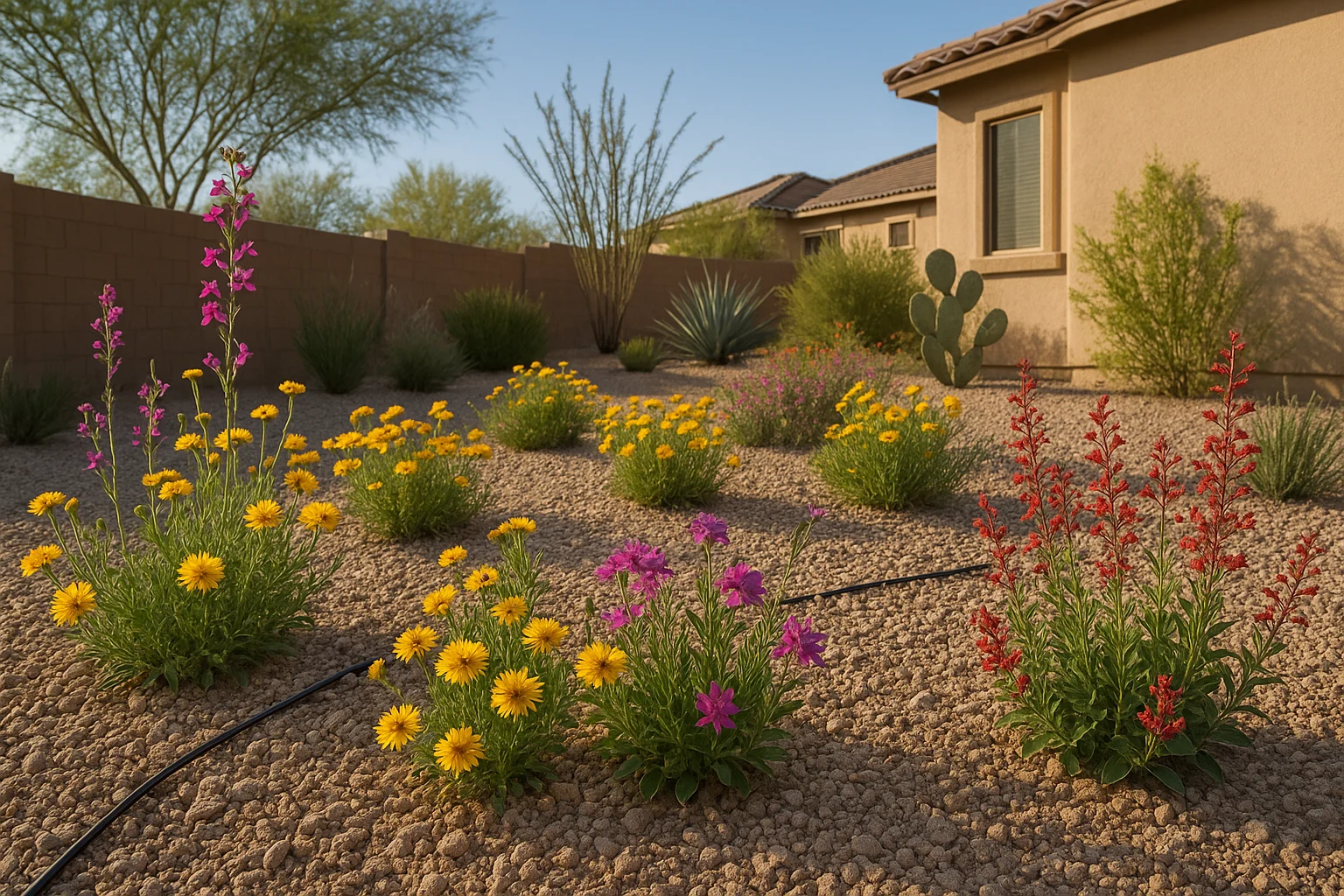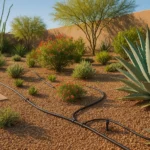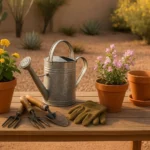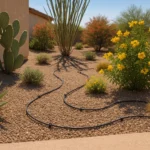Spring in Chandler brings warm sunshine and the perfect opportunity to refresh your yard with vibrant blooms. However, our desert climate demands thoughtful plant selection that balances beauty with water conservation. As your neighbor who’s weathered many Arizona springs, I’m excited to share low-water flower options that will transform your outdoor space into a colorful oasis without draining our precious water resources.

Why Low-Water Flowers Make Sense for Chandler
Living in Chandler means embracing our unique desert environment. With average rainfall barely reaching 9 inches annually and spring temperatures quickly climbing into the 90s, traditional flower gardens can become water-guzzling liabilities. Low-water flowers, also called drought-tolerant or xeric plants, have evolved specialized adaptations like waxy coatings, small leaves, or deep root systems that help them thrive with minimal irrigation.
Beyond the practical water savings—which can reduce your water bill by 30-50%—these resilient plants typically require less maintenance and fewer chemical inputs. Many drought-tolerant varieties attract local pollinators, enhancing your yard’s ecological value while creating stunning visual displays. As water conservation becomes increasingly important in our community, choosing these adapted plants represents responsible landscaping that still delivers the color and joy we all want from our gardens.
The key to success is selecting varieties that not only tolerate our low-water conditions but actually thrive in them. When properly established, these plants develop stronger root systems and greater resilience than their thirstier counterparts, making them perfect long-term investments for your Chandler landscape.
Spring-Blooming Desert Natives for Effortless Beauty
Desert natives offer unmatched adaptation to our local conditions. Penstemon species, particularly Parry’s Penstemon (Penstemon parryi), produce stunning pink-to-purple tubular flowers on tall stalks from February through April. These showstoppers attract hummingbirds and require almost no supplemental water once established. Another spectacular native, the Desert Marigold (Baileya multiradiata), brightens yards with cheerful yellow blooms from spring through fall, reseeding itself year after year.
For dramatic impact, consider adding Blackfoot Daisy (Melampodium leucanthum), which creates mounds of small white flowers with yellow centers from spring through fall. These hardy natives thrive in our alkaline soils and intense sun, forming attractive ground covers that suppress weeds naturally. The delicate-looking Desert Bluebells (Phacelia campanularia) deliver striking blue-purple flowers that contrast beautifully with our desert landscape, blooming profusely after spring rains.
When incorporating natives, group them according to water needs and give them space to reach their natural size. Most desert natives prefer well-draining soil and benefit from a light layer of gravel mulch that mimics their natural habitat. While they need regular water during their first growing season, most will thrive on rainfall alone after establishment, perhaps with occasional deep watering during extreme drought periods.
Mediterranean Beauties That Love Our Climate
Plants from Mediterranean climates share our hot, dry growing conditions and transfer beautifully to Chandler gardens. Lavender varieties, particularly Spanish lavender (Lavandula stoechas) and ‘Goodwin Creek Grey’, produce fragrant purple spikes in spring while requiring minimal water. Their silver-grey foliage adds year-round texture and complements desert plants perfectly. Similarly, rosemary not only provides culinary benefits but also produces delicate blue flowers in spring that pollinators adore.
Salvia varieties offer incredible diversity for Chandler gardens. Mexican Bush Sage (Salvia leucantha) creates dramatic purple-white flower spikes, while the compact ‘Hot Lips’ salvia delivers red and white bicolor blooms from spring through fall. These plants establish quickly and become increasingly drought-tolerant with age. Another Mediterranean standout, Jerusalem Sage (Phlomis fruticosa), produces unusual whorls of bright yellow flowers on architectural stems above fuzzy, gray-green leaves.
When planting Mediterranean varieties, provide excellent drainage and avoid overwatering, which can lead to root rot. Most prefer full morning sun with light afternoon shade during our hottest months. A 2-3 inch layer of mulch helps retain soil moisture while keeping roots cool. For best results, plant these beauties in fall or early spring, allowing them to establish before summer’s intense heat arrives.
Colorful Perennials That Return Year After Year
Drought-tolerant perennials offer tremendous value, returning with bigger displays each spring. Blanket flower (Gaillardia) produces daisy-like blooms in fiery red-orange-yellow combinations from spring through fall, attracting butterflies while tolerating poor soil and minimal water. The ever-popular Purple Coneflower (Echinacea purpurea) not only creates stunning purple-pink blooms but also develops deep roots that enhance its drought tolerance over time.
For dramatic vertical interest, consider Autumn Sage (Salvia greggii), which despite its name begins flowering in spring with red, pink, or coral tubular blooms that continue through fall. This versatile plant thrives in our alkaline soil and intense sun. Gaura, sometimes called Whirling Butterflies, produces airy white or pink flowers that dance in the slightest breeze, creating movement in the garden while requiring minimal care and water.
Most perennials benefit from being cut back in late winter before new growth emerges. This practice removes dead material, improves air circulation, and stimulates vigorous spring growth. When designing with perennials, plant them in odd-numbered groups (3, 5, or 7) for natural-looking drifts that create greater visual impact. Water deeply but infrequently to encourage deep root development, gradually extending the time between waterings as plants become established.
Spring-Flowering Bulbs and Tubers for Desert Gardens
Several bulbs and tubers thrive in our low-water conditions while delivering spectacular spring displays. Rain lilies (Zephyranthes) remain dormant until rainfall triggers their star-shaped white or pink blooms, making them perfect for rain gardens or areas that receive natural runoff. Similarly, Desert Lily (Hesperocallis undulata) emerges after winter rains to produce elegant white trumpet flowers on tall stalks before retreating underground during summer dormancy.
For reliable spring color, few plants match bearded iris for drought tolerance and visual impact. These architectural beauties produce ruffled blooms in virtually every color imaginable while their thick rhizomes store water for lean times. Plant them with the rhizome partially exposed and in full sun for best flowering. Another excellent choice, Amaryllis belladonna (Naked Lady Lily), remains dormant until late summer when dramatic pink blooms emerge on leafless stalks, earning their curious nickname.
When incorporating bulbs into your Chandler landscape, remember that most require a dry dormant period, making them perfect companions for other drought-tolerant plants. Place them where they’ll receive winter and spring moisture but stay relatively dry during summer. Avoid overwatering during dormancy, which can cause bulbs to rot. Many bulbs naturalize over time, creating larger displays each year with no additional effort on your part—the perfect investment for water-wise gardening.
Creating Stunning Container Displays with Low-Water Flowers
Containers offer perfect opportunities to showcase drought-tolerant flowers, especially in small spaces or around patios. For spring displays, combine trailing Purple Verbena with upright Angelita Daisy and spiky Blue Fescue grass for a container that balances form and color while sharing similar water needs. Potted cactus displays can also be enhanced with flowering companions like Blackfoot Daisy or compact Penstemon varieties that complement without competing.
When creating drought-tolerant containers, material selection matters significantly. Terra cotta pots, while beautiful, dry out quickly in our climate. Consider glazed ceramic containers that retain moisture longer while still providing excellent drainage. Regardless of container type, use a high-quality potting mix specifically formulated for cacti and succulents, which provides the sharp drainage these plants require. Adding a layer of decorative gravel on the soil surface reduces evaporation while creating a finished look.
Even drought-tolerant container plants need more frequent watering than their in-ground counterparts. Develop a routine of checking soil moisture by inserting your finger an inch below the surface—water only when the soil feels dry at this depth. During spring’s moderate temperatures, most low-water containers need watering just once or twice weekly, though this increases as temperatures climb. Group containers with similar water needs together to simplify maintenance and prevent overwatering.
Smart Watering Strategies for Spring Flower Success
Even drought-tolerant flowers need proper watering, especially during establishment. The key is watering deeply but infrequently to encourage deep root growth. For new plantings, water thoroughly at planting time, then every 2-3 days for the first two weeks. Gradually extend the time between waterings to 5-7 days, then 7-10 days as plants establish. By summer, most low-water flowers should thrive with watering every 10-14 days, depending on temperatures and rainfall.
Irrigation method significantly impacts water efficiency. Drip irrigation delivers water directly to plant roots, reducing evaporation and preventing the fungal issues that can develop with overhead sprinklers. Smart controllers that adjust watering based on weather conditions can reduce water use by 15-30% while improving plant health. Consider installing a rain sensor that automatically skips scheduled watering after significant rainfall—a simple device that prevents wasteful overwatering during our precious spring showers.
Timing matters too. Water early in the morning (before 8 am) when temperatures are cooler and winds calmer, maximizing absorption while minimizing evaporation. Apply water slowly enough that it soaks in rather than running off, especially on our clay-heavy Chandler soils that can become hydrophobic when dry. Proper moisture balance is essential for healthy plants, so monitor your garden regularly, looking for signs of stress like wilting or leaf curl that indicate watering needs.
Maintaining Your Low-Water Flower Garden Through the Seasons
Spring preparation sets the stage for success. Begin by clearing away winter debris and applying a fresh 2-3 inch layer of mulch around (but not touching) plant crowns. This single step dramatically reduces watering needs while suppressing weeds. Early spring is also ideal for applying a light application of slow-release, low-nitrogen fertilizer—drought-tolerant plants generally need less fertilizer than traditional garden flowers, and excess nitrogen can actually reduce flowering while creating unsustainable lush growth.
As spring progresses into early summer, deadheading spent blooms encourages continued flowering in many species. Some plants, like Penstemon, benefit from leaving a few spent flower stalks to produce seeds for natural reseeding. Monitor for pests, particularly aphids that emerge in spring, but resist reaching immediately for chemicals—a strong spray of water often dislodges these pests effectively. For persistent problems, insecticidal soap provides targeted control with minimal environmental impact.
By planning now for summer’s challenges, you’ll enjoy a more resilient garden. Consider installing shade cloth or planting taller plants to protect more delicate specimens from intense afternoon sun. Gradually reduce watering frequency as spring transitions to summer, allowing plants to adapt naturally to changing conditions. Remember that even drought-tolerant plants look their best with appropriate, if minimal, care—the goal isn’t to starve plants of water but to use this precious resource efficiently while creating beautiful outdoor spaces.





